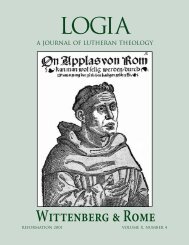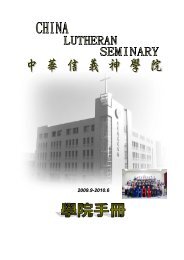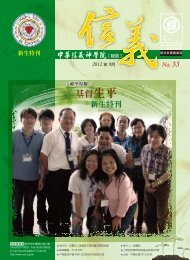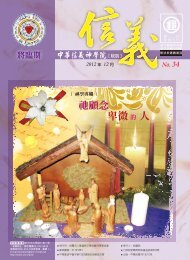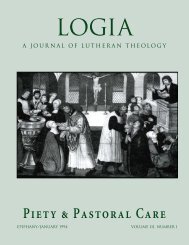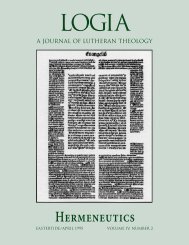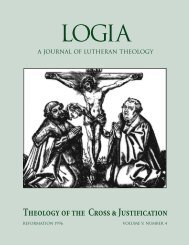Create successful ePaper yourself
Turn your PDF publications into a flip-book with our unique Google optimized e-Paper software.
called & ordained 27<br />
'<br />
NOTES<br />
1. Ernst Käsemann, “Paul and Early Catholicism,” New lutherischen Bekenntnisschriften und nach dem Neuen Testa-<br />
Testament Questions of Today, translated by W.J. Montague ment,” in Zur Auferbauung des Leibes Christi: Festgabe für Pro-<br />
(Philadelphia: Fortress Press, 1969), p. 243.<br />
fessor D. Peter Brunner zum 65. Geburtstag, edited by Edmund<br />
2. Käsemann, pp. 245 V.<br />
Schlink and Albrecht Peters (Kassel: Johannes Stauda-Verlag,<br />
3. Käsemann, p. 245: “<strong>The</strong>re is for Paul no extension of the 1965), p. 104. To serve means: “nicht nur, sich selbstlos einer<br />
earthly Jesus in the church.”<br />
Aufgabe hingeben, sondern aus Glauben, der auf Recht und<br />
4. Käsemann, p. 248: “In borrowing from Jewish Chris- Macht verzichtet und Gottes Hilfe bei Jesus sucht, in der Weise<br />
tianity, the church was compelled to bind the Spirit to the Jesu den Menschen Liebe erweisen, um Glauben an Gott und<br />
office.”<br />
Liebe zu den Menschen zu wirken.”<br />
5. One could argue that the pattern begins already at the 15. For a summary, see Riesenfeld, pp. 121 V.<br />
creation. God, the <strong>Holy</strong> One, speaks and through that speaking 16. For example, Paul writes that he bears “in his body the<br />
makes for Himself a people, Adam and Eve, who are according marks (stivgmata) of Jesus” (Gal 6:17). <strong>The</strong>re are a number of<br />
to his image and likeness. However, the typology of redemp- good studies on Paul’s understanding of his apostolic office.<br />
tion and promised blessing which dominates the biblical narra- Bengt Holmberg, Paul and Power (Lund: Studentlitteratur,<br />
tive is that of the Exodus from Egypt under the leadership of 1978), pp. 14-123; John Schuetz, Paul and the Anatomy of Apos-<br />
Moses.<br />
tolic Authority (Cambridge: Cambridge University Press);<br />
6. Brevard Childs, Old Testament <strong>The</strong>ology in a Canonical David M. Stanley, “Authority in the Church: A New Testament<br />
Context (Philadelphia: Fortress, 1985), p. 153.<br />
Reality,” CBQ 29 (1967), pp. 555-573; David M. Stanley,<br />
7. Harald Riesenfeld, “<strong>The</strong> <strong>Ministry</strong> in the New Testa- “‘Become Imitators of Me’: <strong>The</strong> Pauline Conception of Aposment,”<br />
in <strong>The</strong> Root of the Vine: Essays in Biblical <strong>The</strong>ology tolic Tradition,” Biblica 40 (1959), pp. 859-877; Erhardt Güttge-<br />
(Westminster: Dacre Press, 1953), p. 100.<br />
manns, Der leidende Apostel und sein Herr: Studien zur paulinis-<br />
8. It was prophetic promise that in the end times God chen Christologie (Göttingen: Vandenhoeck & Ruprecht, 1966).<br />
would gather in his dispersed people and dwell with them in a 17. <strong>The</strong> Greek construction is important here: ta; de; pavnta<br />
renewed Jerusalem (see Is 5:26; 11:10, 12; 49:22; 62:10; Ez 36:24). ejk tou' qeou' tou' katallavxanto" hJma'" ejautw/ dia; Cristou'<br />
<strong>The</strong> Gospel of John especially understands this eschatological kai; dovnto" hJmi'n th;n diakonivan th'" katallagh''"<br />
(2 Cor 5:18).<br />
act of God as beginning in the ministry of Jesus. Note John’s <strong>The</strong> definite article tou' after qeou' governs both participles,<br />
use of the Feast of Booths (Jn 7-8) and his interest in unity (Jn indicating that the reconciling and the giving are not separate<br />
12:32; 17:20 V.). Very likely John’s report of the Feeding of the actions but interrelated and fused.<br />
Five Thousand belongs to this theme: the fragments are gath- 18. Paul continues his defense in 2 Corinthians 12:1-10. Not<br />
ered into twelve baskets (Jn 6:13). <strong>The</strong> choosing of the Twelve his visions but his apostolic sufferings are the essential marks<br />
certainly indicates that Jesus is reconstituting the New Israel of his apostolicity. My opinion is that the “thorn in the flesh” is<br />
with God in its midst.<br />
the apostolic sufferings of Paul. Here also Paul has followed the<br />
9. Riesenfeld, pp. 104-109.<br />
prototype of the suffering of Christ. As Christ asked the Father<br />
10. Riesenfeld, p. 104.<br />
to take his sufferings from him, Paul also has three times<br />
11. Riesenfeld, p. 104.<br />
requested to be relieved of his sufferings (2 Cor 12:8). <strong>The</strong><br />
12. <strong>The</strong> context of Is 40:11 is important. <strong>The</strong> chapter begins “grace” mentioned in 2 Corinthians 12:9 I take to refer to the<br />
with the famous voice crying in the wilderness, which the New apostolic office itself, the receiving of which was the saving<br />
Testament identifies with John the Baptist. <strong>The</strong> one whose moment for Paul.<br />
coming the voice in the wilderness proclaims is the one who 19. Cf. Riesenfeld, p. 122 V.: “Just as his <strong>Ministry</strong> took<br />
will lead the people like a shepherd. As the one whose way was human form because he was incarnate, it will henceforth be<br />
prepared by John the Baptist, Jesus may well have had Isaiah committed to and discharged by men who are invested with his<br />
40:3-11 in mind when he spoke of himself as a shepherd.<br />
authority and act as his representatives. <strong>The</strong> visible nature of<br />
13. Here one should note the thematic unity between the the <strong>Ministry</strong> is thus congruous with the Incarnation. Christ’s<br />
discourse on the “Good Shepherd” who loses no sheep and the own <strong>Ministry</strong> determined the beginnings of the Christian<br />
Feeding of the Five Thousand in which all the fragments are church, as they took shape during his lifetime. In the same way,<br />
gathered up “that nothing be lost” (Jn 6:12).<br />
the <strong>Ministry</strong> is an integral part of the church in the period<br />
14. Cf. Leonhard Goppelt, “Das kirchliche Amt nach den between the Resurrection and the Second Coming.”






